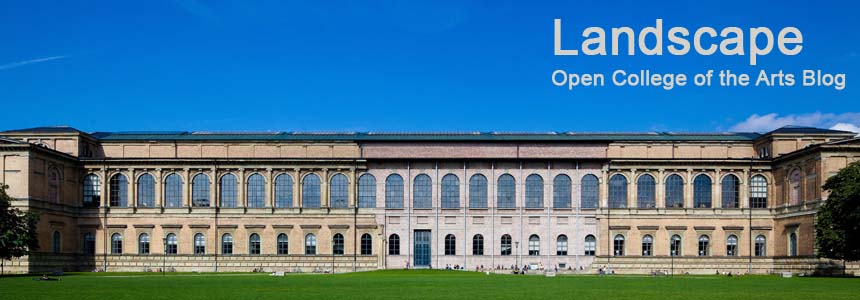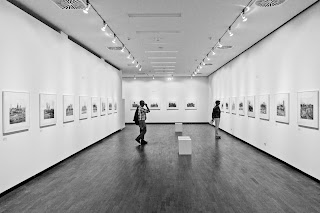The idea of legacy as a thread for assignment 1 is beginning to resonate strongly with me and I am considering extending it beyond the current piece of work into other aspects of the course. I am working within a primarily urban context; the buildings and spaces I image occupy more than simply a 3 dimensional physical world, they also have a temporal existence, their history stretching backwards and potential stretching forwards in time. In Munich this is particularly true, history permeates everything, the legacy of the past still constrains the behavior of the present. The city has a long history, stretching back to a first mention in the records of 1158, however, it is the past 100 years that have defined it's footprint on the world, and a terrible one it has been.
To photograph in and around Munich, it is impossible to avoid the 3rd Reich and the malign influence of Adolf Hitler on the first half of the 20th century. Small and large reminders exist in every district and neighbourhood. To date I have avoided this as an angle within my work, not really sure how to pull it together into a coherent whole, the narrative is certainly there, however, how would I create meaningful images to support a 10-12 photograph assignment submission. With the advent of the new PWDP course and its emphasis on publishing, I have started to revisit this idea, a series of 80 or more images could be worked together into a narrative that explores the remaining legacy of those times. I am still unsure as to how I would develop this in my current course, so it may be necessary to park this idea for future consumption.
Poor weather has forced a break in the development of imagery for the assignment, so yesterday Heidi and I headed into town to visit the Becher exhibit (More about this later), on the way we stopped to take a look at some of the more obvious legacies of the 1930's and 40's. We live in a district of Munich called Bogenhausen, an area renowned for an area of large houses occupied by the wealthy elite of the city, as well as plenty of flats for the less well healed such as me. Bogenhausen has been a focus for the wealthy and powerful for some time, just around the corner from where I live is the house that Hitler purchased for Eva Braun. More remarkable to me is that the large apartment that he called home is still standing, although now acting as a Police station.

All over Munich there are reminders of Hitler, although you need to look for them carefully, they are understandably not marked with nice little blue plaques. There are bars he used to frequent, other dwellings, meeting halls, and even the Nazi Party HQ still stands in its original place. This offers potential, but only if I can find a way to image the places that works with both the narrative and as interesting photographs.
Another legacy of WW2 is the existence in Munich of over 22 air raid bunkers. These bunkers stand above ground. At the time it was too expensive and would have needed too much time to dig them into the ground. The answer was to build massive vertical bunkers, typically 4-5 stories tall and possessing steel reinforced concrete walls with a thickness of 80-100cm. Topped by an ant-aircraft battery these bunkers were designed to withstand a direct hit as well as to protect the inhabitants against shrapnel and falling buildings. They were so well constructed that they are more or less impossible to demolish, attempts using explosives failed. This means they still stand, many subverted into art galleries or offices. A cluster of 4 of them is just around the corner.
This one is close to the city center.
Most of them are in and around the industrial areas of Munich, designed to enable workers to rapidly access them as air raid sirens sounded. As with these two they have been painted and roofed to disguise their original intent, however, they are permanent reminders of the wartime years.
Bunkers
There is also a personal link, the batteries of guns that topped the towers were largely staffed by the Hitler Youth, however, many young women were press ganged into the airforce to serve the guns. My wife's mother was one of these people, forced to fight for a regime what murdered half of her family. She is remarkably sanguine about this part of her wartime experience, however, she departed Germany for the US as soon as she could and is now a proud American citizen. It is ironic that the guns she served fired at the airmen of the country she was shortly to become part of, particularly as her future husband was WW2 USAF bomber crew, but fortunately in the Pacific theater.
There are roughly 22 of these scattered across the city, a thought has struck that I could attempt a typography of these buildings, inspired by the work of the Bechers, similarly in B&W and with a coincidental approach of similar framing and structure.
The darkest legacy of the 3rd Reich is undoubtedly the slaughter than took place in the concentration camps, a subject difficult to approach and fraught with difficulties in presenting even a degree of the suffering. However, this is a part of Munich's legacy to the world and any exploration of the Nazi past would need to include this aspect. Close to Munich is the town of Dachau notorious as the site of the first concentration camp opened by the regime. It was used to house political opponents to the regime, and although many people died there (more than 30,000) it's primary purpose was not as part of the final solution. It still stands in place, a memorial to the deaths inflicted by the regime, above the gates is written "Arbeir macht Frei", three words with a terrible echo. I have never been there, even writing about it is a challenge for me, but, photographs of this site would be an essential part of the study I am considering. This would be a piece of work that will challenge in ways deeper than artistic questions.
Within the city itself a strong Jewish community was all but erased, few reminders remain of a people who were a major part of the population. A new subway line is being planned for the city and prior to its construction a dig has begun to excavate the old Jewish quarter, just behind the city center town hall:
It is strange to look into the cellars of these long destroyed buildings and wonder what lives were led there. More recently a major Jewish center has been built in the city with a remarkable synagogue, Munich's Jewish community is slowly rebuilding and reclaiming it's place in society.
I have processed these images in Black and White, a medium that seems to suite the somber subject matter, but also suits the weather we have had recently. Colour treatment will be a key question for this project, my usual bright saturated colours will not work well in the context of suffering I will need to expose.
It is important not to dwell too much on Munich's Nazi past, very few of the current population were old enough to participate in the evil of the 30's and 40's, many people are sick and tired of its constant reminder. As an Englishman who grew up in the 60's and 70's the war was an essential part of my childhood culture; we played at war, the Germans were always the bad guys, my comics featured heroic commandos and fighter pilots, and the films I watched bounced bombs across lakes or jumped motorbikes into barbed wire. For me it is hard to escape from this programming. Munich is over 800 years old, the wall in the background dates back to the cities origin, there is history every where you look in this city. There are the palaces of the Kings of Bavaria, beautiful Baroque and Rococo churches, Jugendstil architecture, and the intellectual legacy of the artists, philosophers, and scientists who made the city their home. Much of what Munich has represented in the past is good and noble.

I love this city, it is my adopted home and my playground, as a subject for photography it has everything I could ask for, exploring it's past fascinates and at times horrifies. Whilst this project might become an interesting, even compelling activity, I must also look to the positive. In a sense this is what underlies my current assignment, the positive present and future of a city with a dark and distressing past.























































